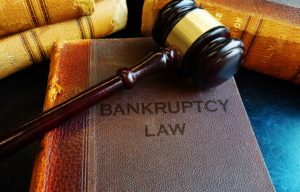
Bankruptcy Law books with court gavel
Section 523(a)(3) of the Bankruptcy Code states in relevant part as follows:
(a) A discharge under [chapter 7] * * * does not discharge an individual debtor from any debt –
* * * *
(3) listed nor scheduled * * * in time to permit –
(A) if such debt is not of a kind specified in * * * [§523(a)(2), (4), or (6)], timely filing of a proof of claim, unless such creditor had notice or actual knowledge of the case in time for such timely filing; or
(B) if such debt is of a kind specified in * * * [§523(a)(2), (4), or (6)], timely filing of a proof of claim and timely request for a determination of dischargeability of such debt under one of such paragraphs, unless such creditor had notice or actual knowledge of the case in time for such timely filing and request * * * *
In re Beezley, 994 F.2d 1433, 1435-37 (9th Cir. 1993), stands for the proposition that Section 523(a)(3) does not apply to no asset bankruptcies. Beezley reasoned that since Section 523(a)(3) uses the phrase “in time to permit * * * timely filing of a proof of claim,” that the no-notice/no discharge provision does not apply to no asset cases since no bar date is ever established and, therefore, no claim is ever rendered untimely. Courts that have filed this approach usually stress the fact of the absence of prejudice and of the existence of other remedies for the un-notified creditor (e.g., if the debtor acted with a fraudulent intent or if unlisted assets are later discovered.)
In re Corn, 2018 WL 6930389 (Bankr. W.D.Ark. August 30, 2018), involved a debtor’s motion to reopen his case. The debtor explained that the purpose of the motion was “to add a pre-petition, general unsecured creditor that was inadvertently omitted from the Debtor’s schedule F.” Because the case was a “no-asset” case, the court denied the motion as “legally irrelevant.” In doing so, the court noted that Section 523(a)(3)(A) dealt with debts that are not in the category of the intentional tort claims listed under Section 523(a)(2), (4), or (6). It further noted that in the case of a “no-asset” case, the fundamental right to file a claim in the debtor’s case and participate in the distribution of assets never occurs. The Notice of Chapter 7 Bankruptcy Case that is issued in a chapter 7 case states in the title that there is no proof of claim deadline; further, on the second page the notice requests that a creditor not file a proof of claim unless it receives a notice to do so. “Because there is no deadline established within which a creditor can “timely fil[e] a proof of claim,” Section 523(a)(3)(A) is not applicable. Citing to Beezly, the court stated that in other words, “ ‘there can never be a time when it is too late ‘to permit timely filing of a proof of claim.’ ’ ” Id. at *1. Therefore, “[r]eopening a case simply to schedule that creditor is ‘for all practical purposes a useless gesture.’” Id.
The Seventh Circuit took a different approach in In re Stark, 717 F.2d 322 (7th Cir. 1983). In Stark held that in a no asset case, the discharged debtor could ask the bankruptcy court to reopen the proceeding to list belatedly a creditor who was innocently omitted and who would have received no benefit from notice. Id. at 324. The court noted however that such a course properly leaves the burden on the debtor to show that the law and equities justify such relief – absent which the debt will remain undischarged.
A similar conclusion was reached in Colonial Sur. Co. v Weizman, 564 F.3d 526 (1st Cir. 2009), which held that nothing in the language or history of Section 523(a)(3) indicates that Congress aimed to carve out no asset bankruptcies from the general rule that listing the creditor is a condition of discharge. The Court stated that the qualifying phrase about timely filing recognizes that notice may be given late in the bankruptcy-proceeding, yet still in time for the creditor to participate.
That the debtor claims to have no distributable assets might make one think that the creditor is not harmed by the lack of notice and so the Ninth Circuit reading is just a shortcut to a no harm, no foul outcome. But no asset claims are easy to make; the creditor might want notice precisely to argue that there are assets even though the debtor asserts otherwise. Id. at 532.
The Court also stated that while it was true that an unnotified creditor is not entirely helpless even after the bankruptcy proceeding is long over, the burden of reopening the case should be fairly upon the debtor who failed to give notice. Id.
The court in In re Jakubiak, 591 B.R. 364 (Bankr. E.D.Wis. 2018), in a 28 page decision, generally disagreed with the reasoning in both Beezley and Stark, but recognized that in our “hierarchical judiciary” “judges of inferior courts must carry out [even those] decisions they believe mistaken” and, therefore, ruled it was required to follow Stark. It then explained the Stark opinion as follows:
Stark means that, in a no-asset case under chapter 7 in which the clerk has given creditors notice that they need not file proofs of claim unless the clerk sends subsequent notice, a debtor who fails to list a creditor with a claim for a garden-variety debt (or to schedule such a debt) may reopen his case after discharge and amend his filings to list the omitted creditor (or schedule the omitted debt), thereby placing the debtor and the creditor in the positions they would have occupied had the debtor properly listed the creditor (or scheduled the debt) in the first place, unless the debtor’s omission was fraudulent or intentional or the creditor was harmed in some way by the omission. If matters are equitably reset, Stark implies that §523(a)(3)(A) does not apply to except omitted garden-variety debts from discharge.
Id. at 392. The court then cited to First Circuit case of Weizman, 564 F.3d at 532 which allegedly provided a good description of Stark::
In Stark, the holding was that * * * a no asset debtor could, long after the discharge, ask the bankruptcy court to reopen the proceeding to list belatedly a creditor who was innocently omitted and who would have received no benefit from notice. But such a course properly leaves the burden on the debtor to show that the law and equities justify this relief—absent which the debt will remain undischarged.
Matthew T. Gensburg
[email protected]

